Japanese roasted sesame dressing adds a wonderful nutty flavour to any salad. Mix it together in minutes, or keep a batch ready to go in the fridge! Naturally vegan.
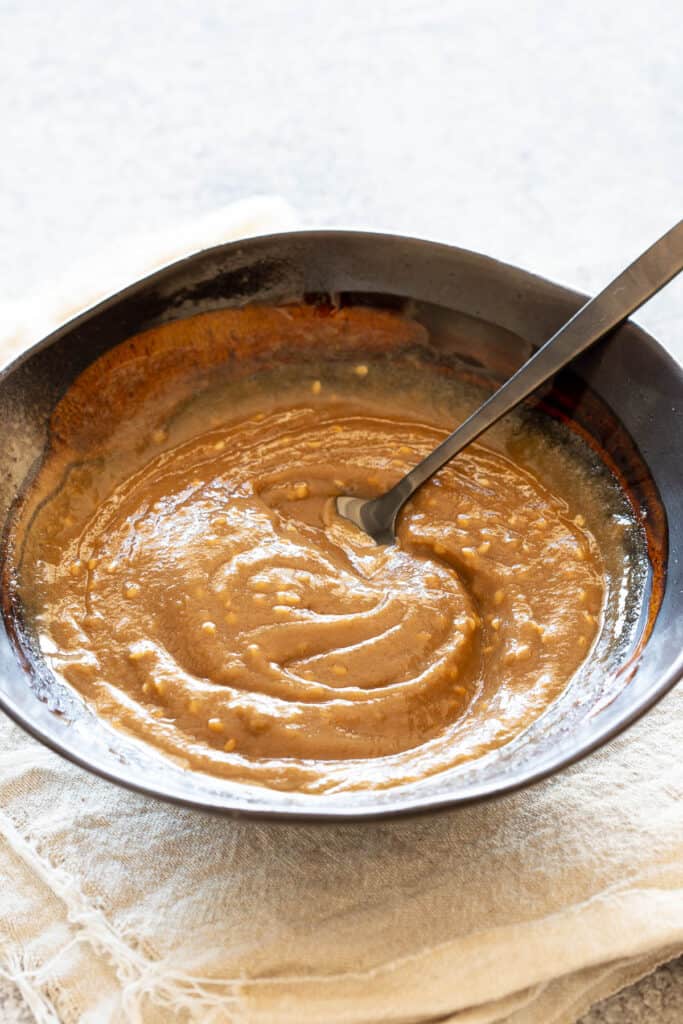
In This Post You’ll Learn
Why We Love This
This is a super versatile dressing that really amps up a dish. You’re guaranteed to never associate the word boring with this sauce!
It makes a really quick lunch when you toss a couple of tablespoons through a batch of udon noodles or soba noodles. You can also add fresh vegetables into the mix to make it go further and add a little extra nutrition.
Related: Goma Dare – Shabu Shabu Sauce / Sarah’s Creamy Sesame Dressing
Japanese Sesame Paste vs Tahini
Japanese Sesame Paste (Goma Shiro or Neri Goma) is usually made from pure roasted white sesame seeds, whereas Tahini is usually made from raw/untoasted sesame seeds. So the flavours will be different.
Traditionally, the recipe for Japanese roasted sesame dressing uses the Japanese sesame paste instead of tahini. However, the paste can be both hard to track down and expensive outside of Japan. So in most cases, it’s easiest to substitute with tahini like we have in our recipe today, along with the addition of toasted sesame seeds for extra roasted flavour.
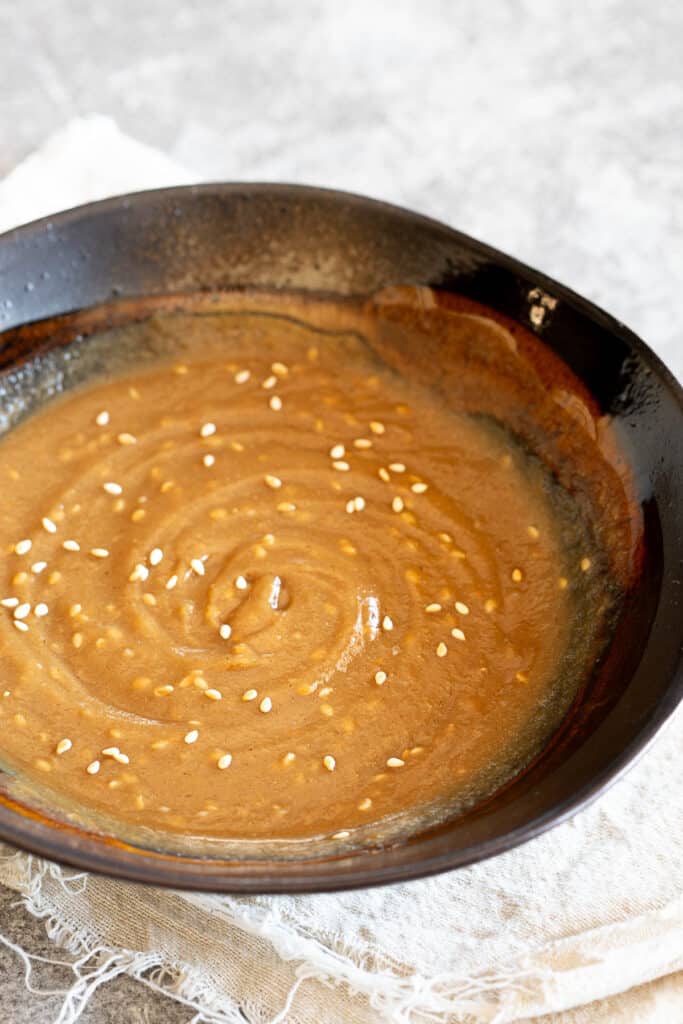
What is Roasted Sesame Dressing?
Japanese Roasted Sesame Dressing is a bright and flavourful sauce made with a base of sesame paste or tahini. It’s often poured over a simple summer salad, fresh or cooked veggies, or used as a noodle sauce base. It’s a nice creamy alternative to the vinegar based Japanese wafu salad dressing.
As it doesn’t contain mayonnaise, this salad dressing is naturally vegan. Of course, if you want a creamier version – you can add a couple of tablespoons of Kewpie mayo or make goma dare or Sarah’s creamy sesame dressing instead.
We’d most often have this dressing out at restaurants, mixed through a simple cabbage or lettuce salad while we were living in Japan. You’d usually find it alongside a bowl of gyoza, karaage or a steaming bowl of curry udon. Back in Australia, we usually make it at home where you’ll find Sarah dipping fresh green beans straight into the sauce as a snack!
What You’ll Need
- Tahini – Made from raw white sesame seeds, it has a less intense roasted flavour. Sub with roasted Japanese sesame paste if you can. Hulled and natural tahini works well, you can also use unhulled or roasted tahini if you can source.
- Toasted Sesame Seeds – Adds that deeper, roasted nutty flavour to this popular dressing.
- Rice Wine Vinegar – Look for this in the international aisle at your local supermarket, otherwise head to an Asian grocer or buy online. If you don’t have this, you can substitute for apple cider vinegar, white wine vinegar, or white vinegar.
- Soy Sauce – Japanese soy sauce such as Kikkoman will work best here, as it’s less salty than other varieties. Otherwise, sub with regular soy sauce or tamari if you need.
- Sesame Oil – We love adding this for a little extra flavour, you can sub with homemade sesame oil or homemade rayu chilli oil if you’d like to add heat along with the sesame oil.
- Other Ingredients – Sugar, salt, water and vegetable oil.
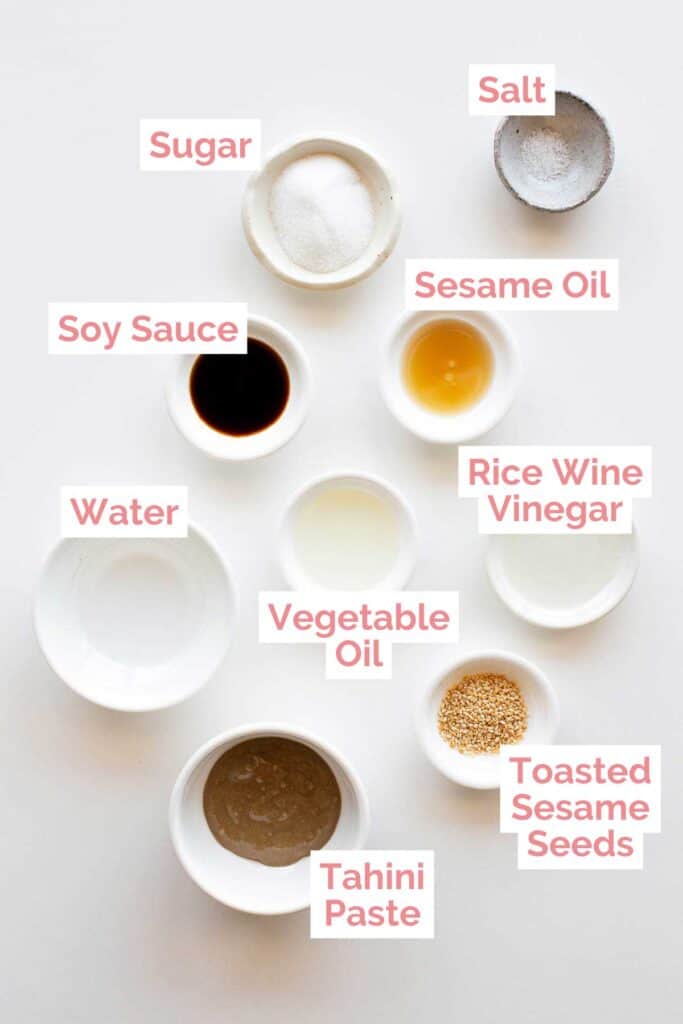
Wandercook’s Tips
- Mix Your Tahini – Homemade or store bought tahini tend to separate between oil and solids, so make sure you give everything a good mix to combine before use.
- Don’t Use Olive Oil – Olive oil, especially extra virgin, can tend to take over the flavour too much and add a bitterness to the dressing, so use a lighter oil where possible.
- Leftover Tahini? – Use it to make tantanmen ramen!
- Storage – Store in a jar in the fridge. It may need a shake or stir before use due to settlement over time. It will last up to a month in the fridge.
FAQs
The options are endless! Pour over salads, fresh vegetables, shabu shabu, cold udon noodles or soba noodles, or yakiniku (grilled meats).
Even try it as alternative sauce for Indonesian gado gado salad! It also goes great over a sushi bowl.
Variations
- Make it Thicker – While the recipe is traditionally quite runny, we love adding double the tahini and making it into a super thick dipping sauce for raw veggies like green beans, cucumber and carrot sticks!
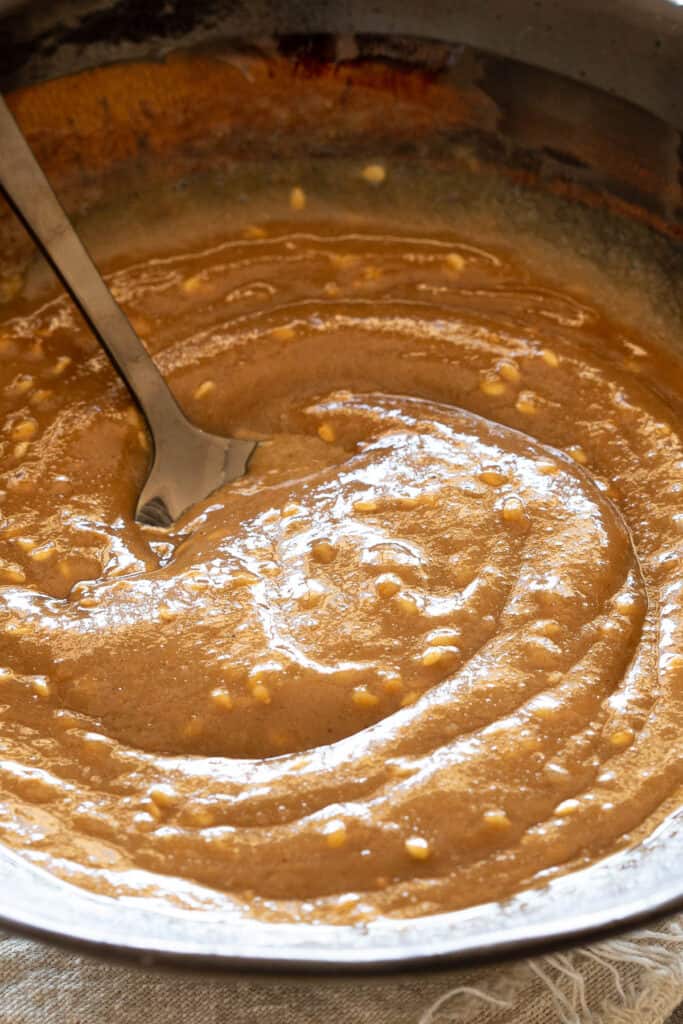
Try these amazing recipes next:
★ Did you make this recipe? Please leave a comment and a star rating below!
Ingredients
- 3 tbsp tahini or 4-6 tbsp for a thick dressing or dip, sub Japanese sesame paste
- 2 tbsp water
- 1 tbsp sugar
- 1 ½ tbsp rice wine vinegar sub white vinegar
- 1 tbsp vegetable oil
- 1 tbsp soy sauce
- 2 tsp toasted sesame seeds sub with fresh
- ½ tbsp sesame oil
- Salt to taste
Instructions
- Optional – Roughly grind your toasted sesame seeds with a mortar and pestle or in a bullet blender with a quick pulse or two.
- Add all your ingredients (tahini paste, toasted sesame seeds, sugar, rice wine vinegar, vegetable oil, sesame oil, soy sauce, salt and water) to a small bowl and whisk together until everything is combined.3 tbsp tahini, 2 tbsp water, 1 tbsp sugar, 1 ½ tbsp rice wine vinegar, 1 tbsp vegetable oil, 1 tbsp soy sauce, 2 tsp toasted sesame seeds, ½ tbsp sesame oil, Salt
- Salad Suggestion: Make a bed of roughly grated lettuce, then top with cucumber and / or tomato slices, roast chicken breast pieces and finally, pour over your roasted sesame dressing.
Video
Recipe Notes
- Mix Your Tahini – Homemade or store bought tahini tend to separate between oil and solids, so make sure you give everything a good mix to combine before use.
- Don’t Use Olive Oil – Olive oil, especially extra virgin, can tend to take over the flavour too much and add a bitterness to the dressing, so use a lighter oil where possible.
- Leftover Tahini? – Use it to make tantanmen ramen!
- Storage – Store in a jar in the fridge. It may need a shake or stir before use due to settlement over time. It will last up to a month in the fridge.
- Make it Thicker – While the recipe is traditionally quite runny, we love adding double the tahini and making it into a super thick dipping sauce for raw veggies like green beans, cucumber and carrot sticks!
Nutrition
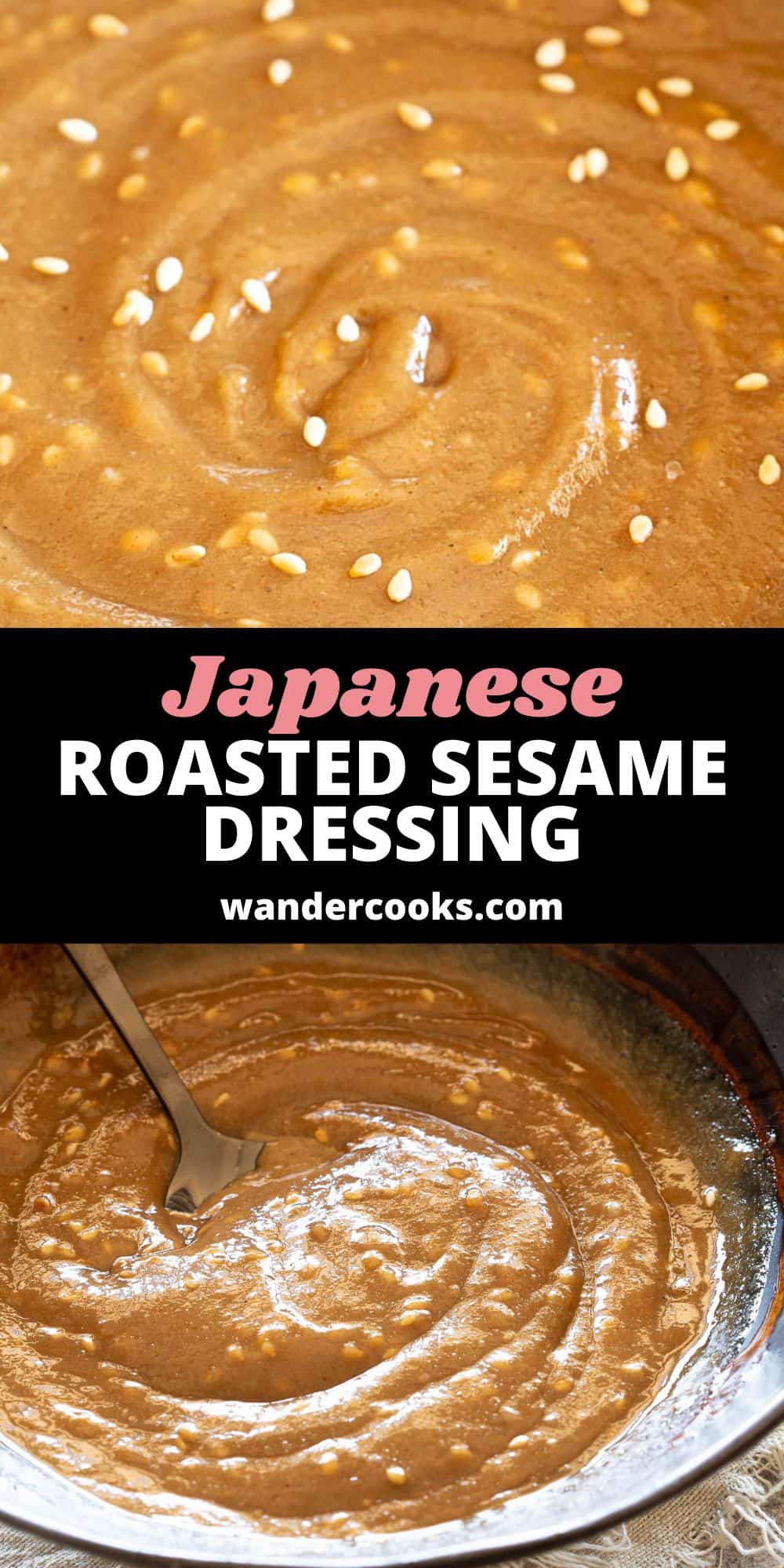

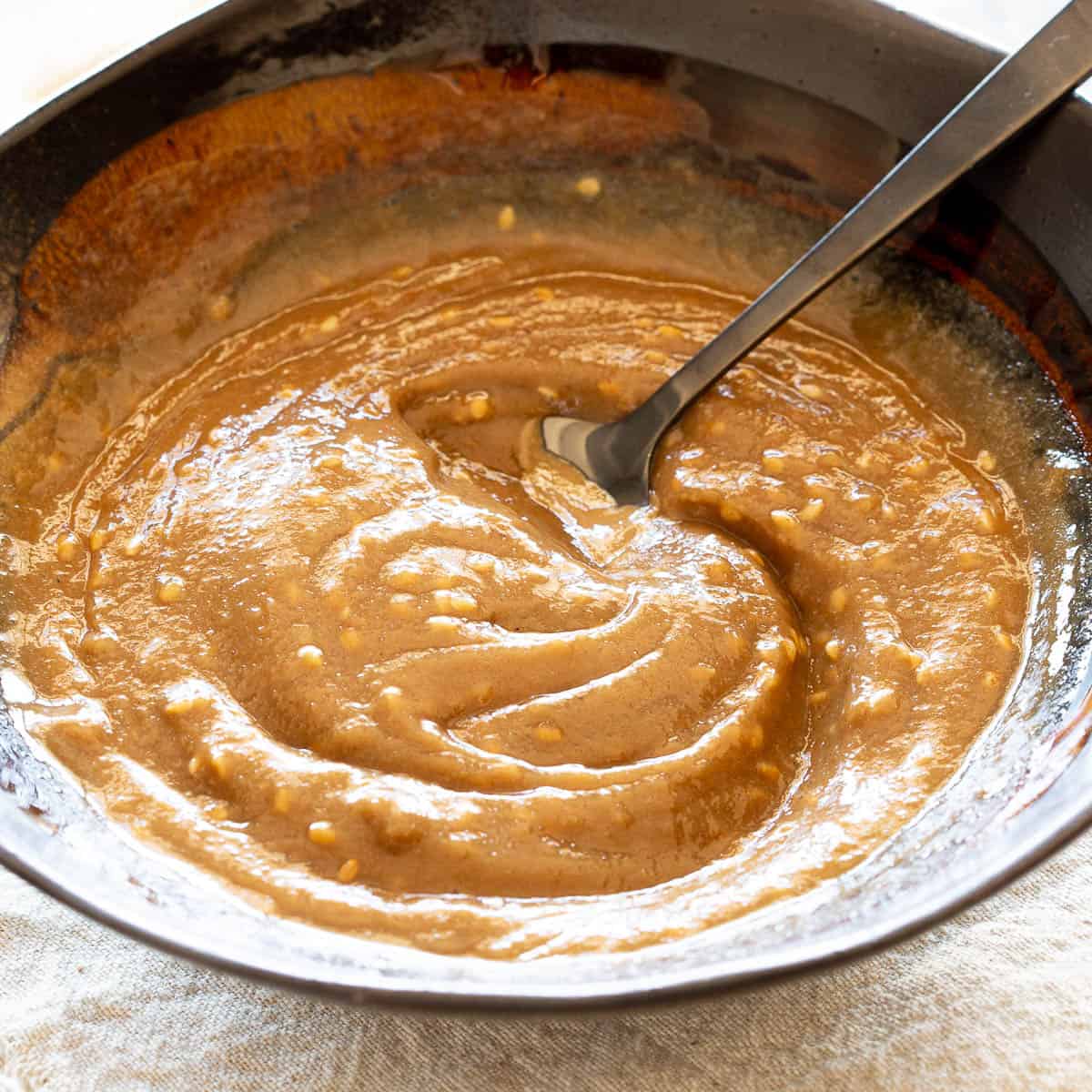



2 Comments
Lucretia Borgia
03/02/2023 at 12:30 pmOh Yummo!
On the money, lovely ladies: superb over Soba noodles (Hakubaku, made in Ballarat, are particularly nice)!
Wandercooks
06/02/2023 at 1:22 pmWoo, that’s awesome. We love Hakubaku, so lucky to have access to organic, Australian made noodles. 🙂